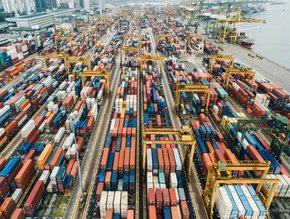How private engagement stimulates public procurement

Public procurement is the process by which governments and public sector organisations purchase goods, services and works from suppliers. The goal is to secure the best value for public money, while ensuring fair and transparent competition among suppliers.
Public procurement plays an important role in the economy by providing opportunities for businesses of all sizes to compete for government contracts. It also helps to ensure that public funds are used efficiently and effectively, while promoting transparency and accountability in the use of public resources.
The processes and skills involved in public sector procurement are the same as those in commercial settings, with one crucial difference: the function is subject to specific legal and regulatory frameworks, which vary by country and jurisdiction.
In general, these frameworks set out rules and procedures for how public sector organisations can buy goods and services, including requirements for tendering, bidding and contract award.
In the US, for example, it is governed by a complex system of laws, regulations and policies at federal, state and local levels. One such law is the Federal Acquisition Regulation, which governs the procurement process for federal agencies. It covers everything from how to solicit bids to how to award contracts.
Public sector procurement in the European Union (EU) is largely governed by a framework of rules and regulations called the EU Procurement Directives, which dictates procedures that must be followed by public sector organisations in the purchasing of goods, services and works.
There are also EU rules around promoting small and medium-sized enterprises, such as the requirement to divide large contracts into smaller lots that can be bid on by SMEs.
In Southeast Asia, meanwhile, public procurement practices vary significantly between countries, since each has its own laws, regulations and procedures.
That said, there are some common themes that apply across the region:
- Centralised procurement In some countries, public sector procurement is centralised at the national level, with a single agency responsible for managing procurement across all government departments and agencies.
- Competitive bidding Most countries require public sector organisations to follow a competitive bidding process when procuring goods and services. This typically involves publishing a tender notice, inviting bids from suppliers and awarding the contract to the supplier that offers the best value for money.
Some of the frameworks around public sector procurement in Southeast Asia are based on national laws or regulations, while others are shaped by international standards and guidelines.
In the UK, public sector procurement is marshalled largely by a framework called the Public Contracts Regulations 2015, which sets out the rules and procedures that must be followed by public sector organisations in their procurement activities.
The Regulations also require public sector bodies to consider environmental, social and ethical considerations when procuring goods and services.
One of the most important procurement positions in the world are those that relate directly to government procurement activities.
Procurement in the UK Government
Gareth Rhys Williams is Government Chief Commercial Officer at the Cabinet Office, which supports the British Prime Minister and helps ensure the effective running of government.
Williams, who has been in the role for seven years, oversees 6,000 staff across all departments, and controls a spend of over £70bn. He is involved in all major commercial transactions across Government.
As public and private procurement continues to converge, boosting both the quality of public services and profits, many companies are wondering how they may tender their products and services and collaborate with the government. For this, it’s important that those relationships are dealt with efficiently.
Public contract management best practice
“There's no point in managing the vendor if you don't also manage the contract,” Williams says. “So we've had 12,000 people now do the basic-level contract management training, and it’s working really well.”
This goes to many aspects in procurement which in recent years have been highlighted as requiring the same level of supervision and care after implementation.
Just as digital transformations are not just one-off overhauls, but require steering after launch, contract management abides by the same rules of engagement, and if handled correctly, can yield some impressive fiscal results.
“We have saved £720mn so far,” says Williams, as both the profitability, and the status of public contracts gain traction.
“If you wind the clock back five years, the commercial function in government wasn't well regarded. We had some great people, but too often our good people left and we didn't have the structure or resources to tackle the workload we had.
"So we set up the Commercial Assessment and Development Centre. If you are a commercial specialist and you want to enter the Government Commercial Function, you undergo classroom-based tests and training. Its purpose is to recruit commercially astute professionals into the Government Commercial Function.”
How public procurement reflects public service
The importance of procurement was catapulted into the spotlight following global supply chain disruptions, as we all now know. This realisation wasn't confined to private procurement alone.
Williams says: “We're trying to make the point that we're taking the procurement exercises seriously now. We're tracking our training, and we're tracking our assessments, and it's delivering. In 2021 we made savings of £3.7bn. That is seven teaching hospitals.
"However you look at it, that is a massive freeing up of cash to reinvest in public services.”
Williams points out that at the same time, government vendors are getting more profitable. “So this is about taking waste out of the system. This is not about just beating up on our vendors. We need them to be profitable.”
And of course, the impact of efficient government procurement functions, expands into the wider economy. “Our delivery is getting better and better, year-on-year, and we are working well for the economy,” Williams says.
To ensure that this process is as effective as possible, all parties involved require efficiencies both on the demand and supply side of the equation. So another policy that the UK Government has put in place is around prompt payment.
Williams says: “SMEs are being paid dramatically faster now, not just by us, but through the supply chain.”
The Public Procurement Bill
In light of all the regulations and laws that govern procurement, Brexit was a huge stimulus for change.
Since one in every three pounds of public money, some £300bn a year, is spent on public procurement, the UK government introduced the UK Procurement Bill, to adapt to the change and lay down the necessary framework for an effective domestic procurement system.
The bill includes a number of regulation-making powers which are necessary to ensure that the legislation will continue to facilitate a modern procurement structure for many years to come and will allow the UK to keep pace with technological advances, new trade agreements and ahead of those who may try to use procurement improperly.
Williams says: “The Procurement Bill will replace the current EU regimen for public procurement. It promises simplicity, flexibility and transparency.
As part of the new bill, the government plans to create a simpler and more flexible commercial system in the hopes of better meeting the needs of the country while remaining compliant with international obligations. So this is a fundamental change.”
Commercial Functional Strategic Plan
“Now we have left the European Union, it’s all about simplification, streamlining, and making us more business-to-business in the way that we work with our vendor base and our supply chain, but with everything underpinned by the fair and transparent backdrop we need for public procurement, to make sure there's no hint or trace of corruption or favouritism.”
And there is still so much to be done, and the project is no small feat, but it is one with massive resources and energy being pooled into it. Williams highlights that there is a lot of training to do in this regard.
He says: “There's 15,000 or so procurement professionals in Government that we need to train around the new regulations. We also need to invest in updating our databases, to give much more transparency for citizens to see how contracts are delivering. We also need to be able to track our contract pipelines, so we can see how different vendors are performing.
"This is all part of our Commercial Functional Strategic Plan.”
- UK public procurement: The cost of poor quality dataProcurement Strategy
- What is the US ‘Better Contracting Initiative’?Procurement Strategy
- PWC advises on UK public Procurement Bill reformProcurement Strategy
- How to spot a strong supplier hidden in their bid submissionProcurement Strategy






